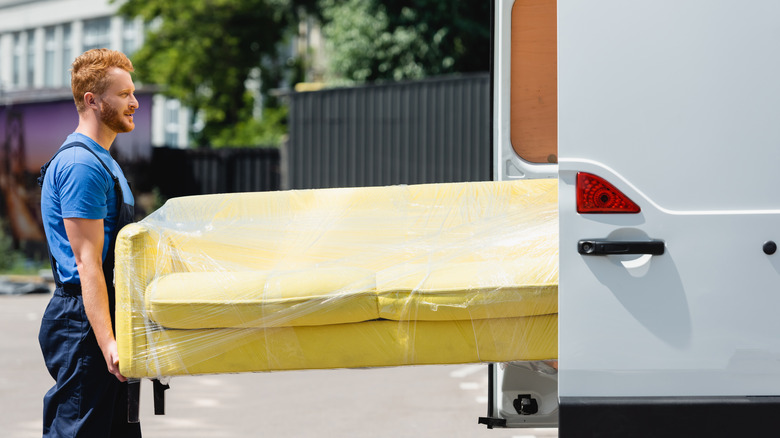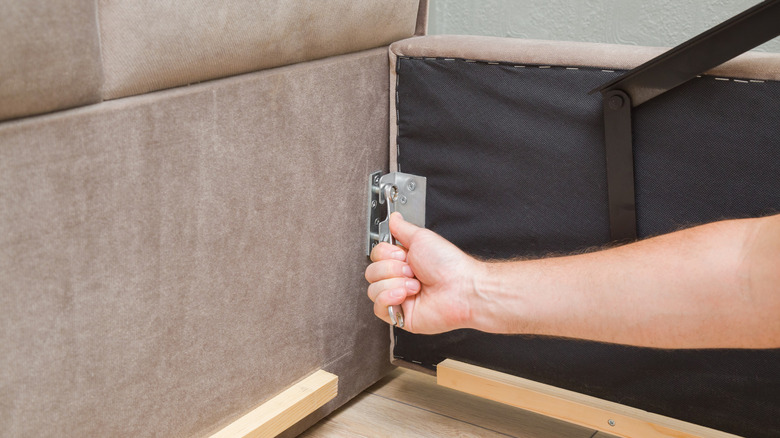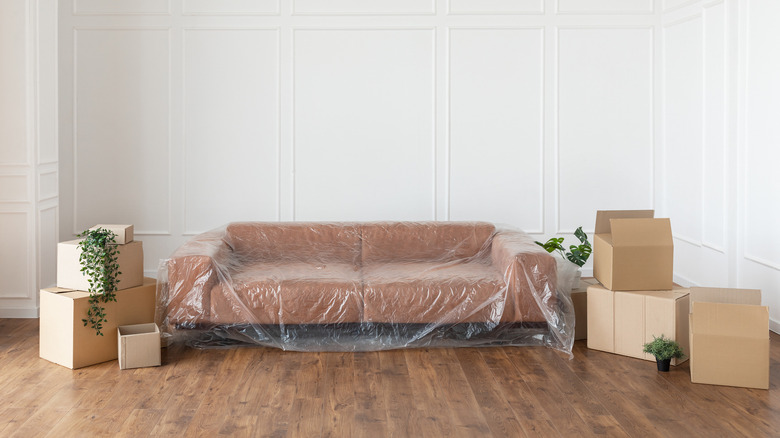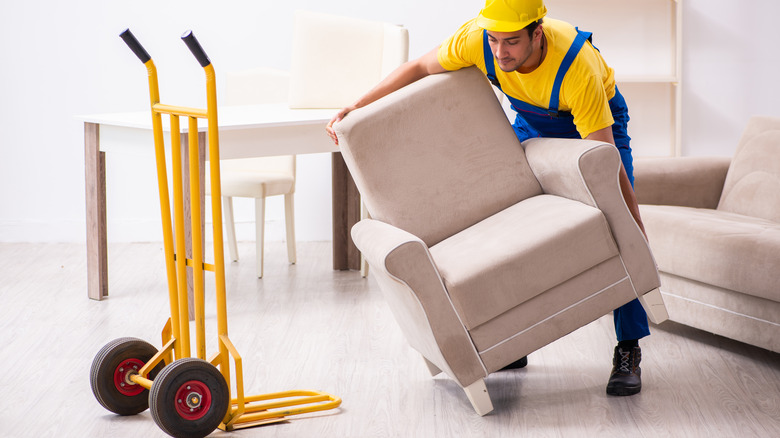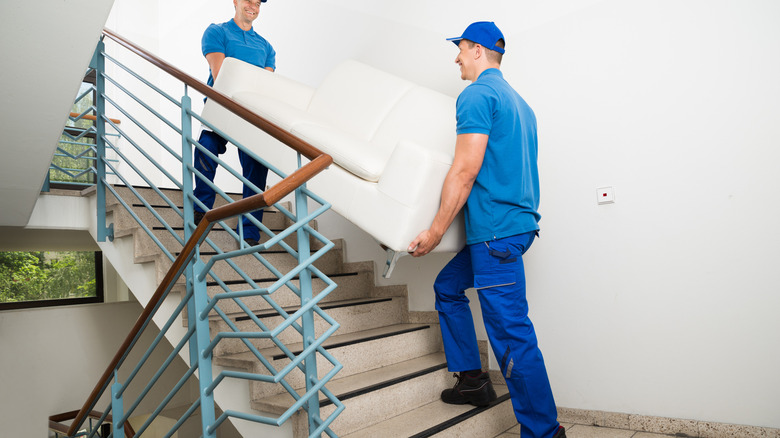How To Easily Move A Couch On Your Own
Moving is naturally mentally and physically exhausting, whether it's just you or a whole crew of movers. Tensions only amplify when you're doing all the heavy lifting. Moving boxes inside your house or apartment to your car or moving truck is difficult on its own, but heavier furniture items present a different set of challenges.
While hiring professional movers is always ideal, it isn't always an option, whether due to high costs or time constraints. Similarly, you may be unable to gather a group of friends to help you vacate in time, and you may find yourself with a heavy couch you have to haul all by yourself. You'll want to be meticulous and thoughtful about this task, taking lots of time to prepare for the physical move. As AQMS National Moving warns, improperly lifting heavy furniture during a move can injure your knees and various body parts. Keep reading to learn how to safely and adequately move a couch on your own.
Clear out the rest of your house
One of the biggest issues with heavier pieces of furniture like couches isn't just the weight but safely and efficiently getting them out of the house. If you're in the process of moving, odds are your home is in various states of disarray, which can make moving your couch difficult and, perhaps, damaging to both you and the furniture.
This is why The Moving Blog recommends, first and foremost, clearing out all pathways and exits. Do this by planning a path from your house to your moving truck, accounting for the width of your couch, turns, etc. Then, ensure this path is clear of any obstacles, clutter, anything you could slip or trip on, etc. Do the same outdoors, making sure there aren't any hidden piles of wet leaves you may accidentally slip on during your journey to the moving truck. Consider putting animals in another room for the time being, too, to ensure they don't mess up your plan.
Break it down
Moving one entire couch by yourself is a task very few are physically equipped for. This is why it's a good idea to disassemble the furniture into as many pieces as possible before carrying it out, per Moving Tips. Removing the arm and cushions of your couch is a lot easier than doing the entire thing at once. It also reduces the likelihood that either your furniture or its components will get damaged in the process.
Begin by extracting your couch cushions, vacuuming them, or even removing the slipcover altogether and throwing it in the washer. These can be wrapped up and thrown in your moving truck. Next, remove the legs and arms. Likely, you'll need to dismantle the former first. Do this by flipping or tilting the couch and using a screwdriver to loosen the screws. The arms are probably attached via the legs with a few bolts connected to the body — remove these as well. Keep all bolts, washers, and screws with their respective piece of the couch, wrap them up, and pack them accordingly.
Wrap it up
Another major cause for concern when moving a couch by yourself is the likelihood of damaging it, whether by accidentally dropping it, rubbing it against the wall, snagging it on a loose plank, etc. This is why you'll often see professional movers wrap your furniture in a tight layer of shrink wrap. As Hire A Helper explains, shrink wrap helps add a layer of protection to your couch while keeping everything in place, and it also protects your furniture in the moving truck.
Begin by purchasing a spool of moving-specific shrink wrap. Since shrink wrap sticks to itself, it can be challenging to use; therefore, consider wearing gloves to apply it, so it doesn't roll onto itself. Simply add a taught layer of plastic wrap around your couch, ensuring you cover every inch. This will also prevent potential friction burns. Also, ensure your couch is completely dry since shrink wrap will lock in moisture, which could lead to mold and mildew growth.
Moving the couch
Now that your pathway is cleared and your couch as lightweight as possible and wrapped tightly in shrink wrap, it's time to move it. This would be a relatively easy task with two people, each person taking up one end. On your own, though, this will be a bit more involved and labor-intensive. Unless you're a bodybuilder or have a massive wingspan, you must use furniture sliders or a dolly. Furniture sliders are a good option for those on a budget. Essentially, they're little pads that you slide under your furniture that help provide a gliding barrier between the furniture and your floors — plastic for carpet and felt for wood — which prevents scratching or tearing, per Dumbo Moving and Storage. Slide the sliders under each leg of your couch, and glide it out to your front door.
Next is where a furniture dolly comes into play. A dolly is a wheeled contraption that helps you quickly move heavy furniture to and fro, and it can be rented at most hardware stores. It may be one solid plank with wheels, or it may have a handle. Either way, you can roll your wrapped couch onto the dolly (optionally strapping it in) and straight to the truck. Hire A Helper warns that you must be careful of hollow back couches. Lay down a sheet of plywood or cardboard first in this case.
Moving up or downstairs
All the above tips are great for moving a couch out of a single-story building, but what about people with stairs? It is highly advised you find someone to help you move heavy furniture like couches up or down flights of stairs for your safety and that of your furniture. However, that's not always possible.
For a task like this, Stor-It recommends using a hand truck — specifically, one made for stairs and going incredibly slowly and carefully, lowering the wheels step by step, taking your time with the process. This can also be done by going up the stairs in reverse. You can also wrap a large blanket or sheet underneath your couch and use the ends as handles, but this is much less secure and better done with at least one other person. If possible, enlist the help of a neighbor or passerby to at least aid with this process.
